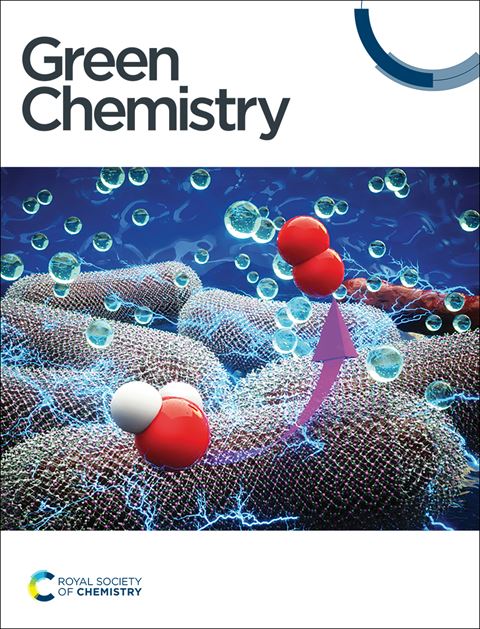2,4,6-Trimethylbenzoyldiphenylphosphine oxide (TPO) analog: a non-cytotoxic type-I photoinitiator for free radical photopolymerization†
IF 9.2
1区 化学
Q1 CHEMISTRY, MULTIDISCIPLINARY
引用次数: 0
Abstract
2,4,6-Trimethylbenzoyldiphenylphosphine oxide (TPO) is a highly efficient and widely used photoinitiator, but it is currently facing significant concerns regarding cytotoxicity. This work investigates a type-I photoinitiator designed as a safer alternative to TPO. In particular, a TPO analog was synthesized, namely 6-(2,4,6-trimethylbenzoyl)-(6H)-dibenz[c,e][1,2]oxaphosphorin 6-oxide (TDOPO), incorporating 9,10-dihydro-9-oxa-10-phosphaphenanthrene 10-oxide (DOPO) motif. This compound presents promising characteristics as a type I photoinitiator. It can be synthesized efficiently in just two steps under mild conditions with a reduced environmental impact using commercially available chemicals, without need for extensive purification procedures. Notably, TDOPO exhibits absorption close to the visible spectrum, suggesting its potential for use in visible light curing applications. Comparative studies reveal that TDOPO exhibits strong photoinitiation ability for the free radical photopolymerization of acrylate in both thin and thick samples. The photochemical mechanism studies indicate its capability to generate three distinct types of free radicals: the 2,4,6-trimethylbenzoyl, an oxygen-centered and a phosphorus-centered free radical. In addition, TDOPO shows no cytotoxicity in a 20-hour assay, a result far superior to that of TPO. These findings underscore the potential of TDOPO as an effective and safer alternative to TPO in photopolymerization processes.

2,4,6-三甲基苯甲酰二苯基氧化膦(TPO)类似物:自由基光聚合的非细胞毒性i型光引发剂
2,4,6-三甲基苯甲酰二苯基氧化膦(TPO)是一种高效且应用广泛的光引发剂,但目前面临着细胞毒性方面的重大关注。本研究研究了一种i型光引发剂,该引发剂被设计为TPO的一种更安全的替代品。特别地,合成了一种TPO类似物,即6-(2,4,6-三甲基苯甲酰)-(6H)-二苯并[c,e][1,2]氧磷蛋白6-氧化物(TDOPO),包含9,10-二氢-9-氧-10-磷菲10-氧化物(DOPO)基序。该化合物作为I型光引发剂具有良好的性能。它可以在温和的条件下用两步有效地合成,减少对环境的影响,使用市售化学品,不需要大量的净化程序。值得注意的是,TDOPO表现出接近可见光谱的吸收,表明其在可见光固化应用中的潜力。对比研究表明,TDOPO对丙烯酸酯的自由基光聚合表现出较强的光引发能力。光化学机制研究表明其能够产生三种不同类型的自由基:2,4,6-三甲基苯甲酰自由基,氧中心自由基和磷中心自由基。此外,在20小时的实验中,TDOPO显示没有细胞毒性,结果远远优于TPO。这些发现强调了TDOPO在光聚合过程中作为TPO的有效和更安全的替代品的潜力。
本文章由计算机程序翻译,如有差异,请以英文原文为准。
求助全文
约1分钟内获得全文
求助全文
来源期刊

Green Chemistry
化学-化学综合
CiteScore
16.10
自引率
7.10%
发文量
677
审稿时长
1.4 months
期刊介绍:
Green Chemistry is a journal that provides a unique forum for the publication of innovative research on the development of alternative green and sustainable technologies. The scope of Green Chemistry is based on the definition proposed by Anastas and Warner (Green Chemistry: Theory and Practice, P T Anastas and J C Warner, Oxford University Press, Oxford, 1998), which defines green chemistry as the utilisation of a set of principles that reduces or eliminates the use or generation of hazardous substances in the design, manufacture and application of chemical products. Green Chemistry aims to reduce the environmental impact of the chemical enterprise by developing a technology base that is inherently non-toxic to living things and the environment. The journal welcomes submissions on all aspects of research relating to this endeavor and publishes original and significant cutting-edge research that is likely to be of wide general appeal. For a work to be published, it must present a significant advance in green chemistry, including a comparison with existing methods and a demonstration of advantages over those methods.
 求助内容:
求助内容: 应助结果提醒方式:
应助结果提醒方式:


